The History Book Club discussion

This topic is about
Catherine the Great
RUSSIA
>
CATHERINE THE GREAT - GLOSSARY ~ (SPOILER THREAD)
date newest »
newest »
 newest »
newest »
 During Catherine's era Jews were exempted from military service and had to pay their extra tax - it was a trade. In 1827 Nicholas I abandoned that and drafted Jews.
During Catherine's era Jews were exempted from military service and had to pay their extra tax - it was a trade. In 1827 Nicholas I abandoned that and drafted Jews. There weren't a lot of Jews in Russia prior to Catherine's era. That changed when Russia got her sections of the Partitions of Poland. This is when Catherine established the "Pale of Settlement" and it was for economic and nationalist reasons. *Note* Massie doesn't go into any of this but I'd like to gently point out that the subtitle of the book is "Portrait of a Woman" not "Dynamic Leader" or "Empress of the Enlightenment." (lol) So I say it to defend him - Catherine's dealings with the Jews or with economics might have been somewhat outside what Massie considered as the scope of his book - just my o.
Anyway - The Pale of Settlement during Catherine's reign:
From http://en.wikipedia.org/wiki/Pale_of_...
The Pale was first created by Catherine the Great in 1791, after several failed attempts by her predecessors, notably the Empress Elizabeth, to remove Jews from Russia entirely, unless they converted to Russian Orthodoxy, the state religion. The reasons for its creation were primarily economic and nationalist.[citation needed]
The institution of the Pale became more significant following the Second Partition of Poland in 1793, since until then, Russia's Jewish population had been rather limited; the dramatic westward expansion of the Czarist Empire through the annexation of Polish-Lithuanian territory increased the Jewish population substantially. At its height, the Pale, including the new Polish and Lithuanian territories, had a Jewish population of over 5 million, and represented the largest component (40 percent) of world Jewish population at that time.
From 1791 to 1835, and until 1917, there were differing reconfigurations of the boundaries of the Pale, such that certain areas were variously open or shut to Jewish residency, such as the Caucasus. At times, Jews were forbidden to live in agricultural communities, or certain cities, as in Kiev, Sevastopol and Yalta, and forced to move to small provincial towns, thus fostering the rise of the shtetls. Jewish merchants of the 1st guild, people with higher or special education, artisans, soldiers, drafted in accordance with the Recruit Charter of 1810, and their descendants had the right to live outside the Pale of Settlement. In some periods, special dispensations were given for Jews to live in the major imperial cities, but these were tenuous, and several thousand Jews were expelled to the Pale from Saint Petersburg and Moscow as late as 1891.
>>>>
And a bit more on Jews and taxes during Catherine's reign:
Jewish communities in Russia were governed internally by local ... Councils ... constituted in every town or hamlet possessing a Jewish population. [These councils] had jurisdiction over Jews in matters of internal litigation, as well as fiscal transactions relating to the collection and payment of taxes (poll tax, land tax, etc.). Later, this right of collecting taxes was much abused; in 1844 the civil authority of the Councils of Elders over its Jewish population was abolished.[4]
http://en.wikipedia.org/wiki/History_...
ME: I think Catherine was not so much anti-semitic as she was promoting the Orthodox faith (as she saw it) for all Russians. Converted Jews were considered Russian Orthodox - period. That said, more tolerance was certainly shown to the German and other Protestants who were allowed to settle in Russia. Even so, Jewish persecution was generally the same (or maybe less virulent) in Russia as in other parts of Europe at this time, and the strength of the persecution (or tolerance) was very changeable in almost all areas.
In Russia persecution of the Jews did get much worse during the reign "anti-semite" and reactionary Alexander III (reign - 1881-1894). In spite of Marxism, this situation endured at least through Stalin's terrors.
 Becky wrote: "During Catherine's era Jews were exempted from military service and had to pay their extra tax - it was a trade. In 1827 Nicholas I abandoned that and drafted Jews.
Becky wrote: "During Catherine's era Jews were exempted from military service and had to pay their extra tax - it was a trade. In 1827 Nicholas I abandoned that and drafted Jews. There weren't a lot of Jews ..."
I want to read "Catherine II: Empress of the Enlightenment!"
 Re: wanting to read "Catherine II: Empress of the Enlightenment"... me too.
Re: wanting to read "Catherine II: Empress of the Enlightenment"... me too. Yes, Massie limits his scope in the book … we learn more about Catherine's lavishing of favors and jewels than we do of how she felt about, for instance, serfdom. But, since he writes of her interest in the enlightenment, with a number of quotes from her correspondence with the European philosophers, I was left curious and longing for some insight on how she could justify her enlightened views on the general state of man with the plight of Russian serfs, who were virtual slaves and chattel. It was interesting to read how some serfs could be educated and talented, even writing and acting in plays for the benefit of their owners, yet were still property, subject to the whims of their owners.
Of course Catherine was only one of many "enlightened" hypocrites in history … even the ancient Greco/Roman philosophers may have owned slaves and many if not most of our own American founding fathers, the men who wrote the Declaration of Independence, ignored the conundrum of their owning slaves.
I assume there were serfs serving Catherine in the palaces and on her properties. Was she not aware of them? Did she consider them less than human, even those with whom she may have had contact? Or was she being pragmatic when she ignored the issue, considering the situation to be one of economics. In any case, in Massie's Chapter 51, The Nakaz, Catherine is quoted as writing that "a civil society requires a certain established order; there ought to be some to govern and some to obey." This seemed to excuse the enslavement of millions. She even declared that their "souls are not their own".
 Just returned from visiting Amsterdam. At the Hermitage Amsterdam there is a painting of Elizaveta Vorontsova-Dachkoval.
Just returned from visiting Amsterdam. At the Hermitage Amsterdam there is a painting of Elizaveta Vorontsova-Dachkoval.http://www.hermitage.nl/en/tentoonste...
Scroll down a bit to see it.
Would not have know who this was if I hadn't been reading along with this book. So cool! Now time to get caught up with the reading -- didn't feel like flying with a hardback.
 This article, "Catherine the Great, Medical Heroine" was written by Duane Jeffrey, a professor at BYU.
This article, "Catherine the Great, Medical Heroine" was written by Duane Jeffrey, a professor at BYU. History often celebrates the wrong people or fixes in the public mind images of others that are significant distortions. Let's review a couple such cases.
Many times, I have been told the history of smallpox vaccination, and always it is how in 1798 one Edward Jenner, an English doctor, vaccinated young James Phipps with some fluid from the pustules of cows afflicted with cowpox.
Sometime later he gave Jimmy some actual smallpox pustule fluid, and Jimmy did not get sick. And so, the story goes, the science and practice of vaccination was born.
But the practice did not begin with Jenner. At least six people are known to have used cowpox to generate smallpox immunity before Jenner did it. And it seems that the practice of inoculation itself had been going on for centuries, though not with cowpox. Rather, one took pus from people with very light cases of smallpox and used that to inoculate others. The recipients usually got very light cases themselves but were subsequently immune to further attack.
Some sources say the practice actually started in the Orient, perhaps China, and came by way of Arab physicians into Europe. It seems to have been called inoculation during those years. Only when cowpox came into use did the term vaccination (from Latin: vacca, cow) come into use. So we can give Jenner credit for energetically promoting the use of cowpox, which carries less risk than using actual smallpox pus, but he certainly did not invent the idea. And frankly, James Phipps deserves more credit than he's usually given (his name is rarely mentioned). Jenner was just doing an experiment; Phipps was gambling his life!
Another who similarly gambled was Catherine the Great, Empress of all the Russias. And she preceded Jenner and Phipps by 30 years. I've usually heard of Catherine as an ambitious and avaricious lady who overthrew (some say killed) her husband to become sovereign of Russia and who was involved with a sordid series of romantic affairs. These stories seem to be considerable distortions of history, but my interests today have to do with smallpox.
Catherine came to power in 1762; Russia was a poor and struggling country. In 1767, a smallpox epidemic in Siberia wiped out some 20,000 people, and Catherine came to believe that reducing its terror would be a great step forward for her people. So at considerable expense she recruited the services of Dr. Thomas Dimsdale of England, the most famous inoculator of the day.
The March 24 issue of New Scientist takes the story from here. Catherine wanted herself and her son to be the first inoculated, to prove to the people that this was a safe and effective procedure. Dimsdale wanted to try his skills with some commoners first, since he was not fully certain that Russian smallpox would behave like the English versions. His attempts were not successful, and Catherine felt that she must take matters into her own hands to establish the credibility of Dimsdale and his work. So on Oct. 12, 1768, she was inoculated. She developed a light case of smallpox but was fully recovered by Oct. 28. And to disprove the popular idea that taking pus from a donor patient would kill that patient, she herself donated pus for inoculation of several members of her court. She and they all survived and inoculation quickly became widely accepted.
Catherine went on to establish the first Russian College of Medicine, and hospitals for civilians. She thus saved the lives of thousands of her people, and seems quite deserving of the nickname she disdained in life: Catherine the Great.

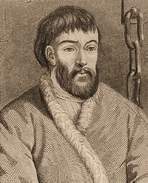
Pugachev's Rebellion of 1773-1774
A.) The Pre-History of the Rebellion
EMILIAN IVANOVICH PUGACHEV was a Don Cossack; he had fought in several wars. In the autumn of 1773 he lead the Ural Cossacks in a revolt which soon was to spread into the Volga basin. He later claimed to be Peter III., the deceased husband of Catherine the Great.
At that time, Russia was at war with the Ottoman Empire, the Russian troops thus had been moved from the area where the rebellion broke out; they were concentrated on the front to the Ottoman Empire. In Russia there was widespread dissatisfaction.
B.) The Military Course of Events
Pugachev capitalized on political dissatisfaction by passing a number of reforms - he had established a kind of alternative government, with chancelery. Among those reforms were the liberation of the serfs, the abolition of taxation and military service, he promised to abolish the landlords. In accordance to tradition, Pugachev claimed to be Catherine's murdered husband Peter III.
Pugachev's troops consisted of cossacks disgruntled about the abolition of their organization, peasants angry about the worsening of their condition, of ethnic minorities (Bashkirs etc.) upset about the infringement on their lands by the Russians, of Old Believers rejecting the state interference in church affairs. Yet the frorce lacked experienced military leaders and acted rather undisciplined.
Early in the rising the Russian administration, the political centers of Moscow and St. Petersburg, seemed almost paralyzed, unable to react on the rebellion. Yet Pugachev took Kazan, but failed to attack the centers. In 1774 an army moved against him, defeated Pugachev's forces repeatedly. Pugachev was betrayed by his own men.
C.) The Legacy
Pugachev was transported to Moscow in a cage, and brutally executed; none of the reforms he implemented were lasting. Catherine, who saw herself as an enlightened monarch, now passed legislation strengthening central control over regional administration and legislation strengthening the institution of serfdom.
 Folks, the glossary thread is to expand on topics in this particular book. Discussion of what is not in the book, no matter how interesting, is probably best saved for your own review.
Folks, the glossary thread is to expand on topics in this particular book. Discussion of what is not in the book, no matter how interesting, is probably best saved for your own review.Great additions Jill, thanks very much.
 The Treaty of Kuchuk Kainardzhi which ended the Russo-Turkish War, handing the Ottoman Empire a humiliating defeat, allowed Catherine's army the freedom to confront Pugachev.
The Treaty of Kuchuk Kainardzhi which ended the Russo-Turkish War, handing the Ottoman Empire a humiliating defeat, allowed Catherine's army the freedom to confront Pugachev. Below is a broadside published at the time of the Treaty which is now housed in the British Museum.
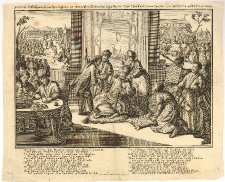
 Kathy wrote: "Just returned from visiting Amsterdam. At the Hermitage Amsterdam there is a painting of Elizaveta Vorontsova-Dachkoval.
Kathy wrote: "Just returned from visiting Amsterdam. At the Hermitage Amsterdam there is a painting of Elizaveta Vorontsova-Dachkoval.http://www.hermitage.nl/en/tentoonste......"
Great find! Thanks for adding it here.
 Siege of Ochakov:
Siege of Ochakov:
More:
http://en.wikipedia.org/wiki/Siege_of...
http://www.prlib.ru/en-us/history/Pag...
http://en.wikipedia.org/wiki/Naval_ac...
 Russo-Turkish War (1787-1792):
Russo-Turkish War (1787-1792):More:
http://en.wikipedia.org/wiki/Russo-Tu...
http://en.wikipedia.org/wiki/Austro%E...
http://www.infoplease.com/ce6/history...
 John Paul Jones:
John Paul Jones:
When peace came Jones returned to Paris to collect prize money for the officers and men of the 'Bonhomme Richard'. He took another mistress Mrs Townsend, the French widow of an Englishman who probably bore him a son. Nothing is known of his fate. Whilst there, Thomas Jefferson, the new American Ambassador, recommended him for service with Russia. In 1788 he was made a Rear Admiral in the Russian Navy by the Empress Catherine II, a rank higher than he had received in the United States. As Kontradmiral check Pavel Ivanovich Jones he served with distinction under Prince Potemkin against the Turks in the Black Sea campaign. At the Battle of Liman he reconnoitred the Turkish Fleet in a rowboat during the night;repulsed the Turkish attacks killing about 3000 Turks,destroying 15 vessels and taking over 1600 prisoners at a cost to his squadron of one frigate and 18 killed. He wrote "I am delighted with the courage of the Russians, which is more glorious because it is without show-off." He was falsely charged with molesting a 10 year old butter seller, Katerina,the daughter of a German immigrant whilst living in St. Petersberg. The charge was dropped but in 1789 after a brief audience with Catherine, Jones left Russia never to return.
(Source: http://www.jpj.demon.co.uk/jpjlife.htm)
More:
http://en.wikipedia.org/wiki/John_Pau...
http://www.history.navy.mil/bios/jone...
http://www.portsmouthhistory.org/john...

 Evan Thomas
Evan Thomas
 Samuel Eliot Morison
Samuel Eliot Morison
 Catherine's son Paul, who became Tsar upon her death. His patrimony is still hotly debated by historians.....was he the son of Catherine's lover, Saltykov or was he really the son of her husband, Peter? The evidence of the famous "Habsburg lip" gives some credence to the theory that he was indeed Peter's son.
Catherine's son Paul, who became Tsar upon her death. His patrimony is still hotly debated by historians.....was he the son of Catherine's lover, Saltykov or was he really the son of her husband, Peter? The evidence of the famous "Habsburg lip" gives some credence to the theory that he was indeed Peter's son.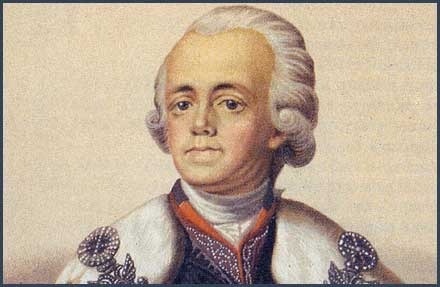
 A summary of the life of Prince Potemkin, the most influential of Catherine's favorites and rumored to be her husband.
A summary of the life of Prince Potemkin, the most influential of Catherine's favorites and rumored to be her husband.Prince Grigory Aleksandrovich Potemkin-Tavricheski was a Russian military leader, statesman, nobleman and favorite of Catherine the Great. He died during negotiations over the Treaty of Jassy, which ended a war with the Ottoman Empire that he had overseen.
Potemkin was born into a family of middle-income noble landowners. He first attracted Catherine's favor for helping in her 1762 coup, then distinguished himself as a military commander in the Russo-Turkish War (1768–1774). He became Catherine's lover, favorite and possibly her consort. After their passion cooled, he remained her lifelong friend and favored statesman. Catherine obtained for him the title of Prince of the Holy Roman Empire and gave him the title of Prince of the Russian Empire among many others : he was both a Grand Admiral and the head of all of Russia's land and irregular forces. Potemkin's defining achievements include the peaceful annexation of the Crimea (1783) and the successful second Russo-Turkish War (1787–1792). The fall of Ottoman stronghold Izmail that he orchestrated prompted Gavrila Derzhavin and Osip Kozlovsky to write Russia's first national anthem, "Let the thunder of victory sound!".
In 1774, Potemkin became the governor-general of Russia's new southern provinces. An absolute ruler, he worked to colonize the wild steppes, controversially dealing firmly with the Cossacks who lived there. He founded the towns of Kherson, Nikolayev, Sevastopol, and Yekaterinoslav (now Dnipropetrovsk). Ports in the region became bases for his new Black Sea Fleet. His rule in the south is associated with the "Potemkin village", a largely fictional method of ruse involving the construction of painted façades to mimic real villages. Potemkin was known for his love of women, gambling and material wealth; he oversaw the construction of many historically significant buildings, including the Tauride Palace in St. Petersburg. A century after Potemkin's death, his name was given to the Battleship Potemkin, which featured in the 1905 Russian Revolution and was fictionalized in The Battleship Potemkin by Sergei Eisenstein.
Source: Wikipedia
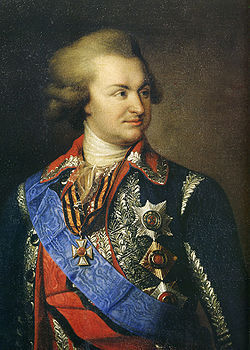
 The Crimea was a point of contention between Russia and Turkey for many years.....but do you know exactly where it is located? This map helps.
The Crimea was a point of contention between Russia and Turkey for many years.....but do you know exactly where it is located? This map helps.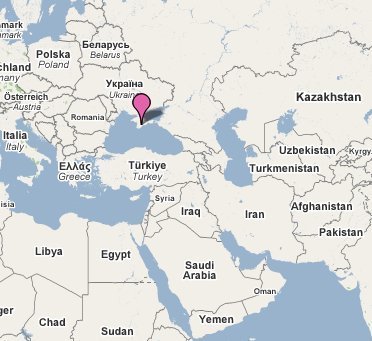

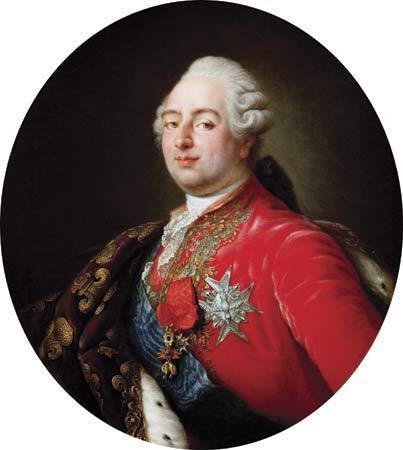
Louis XVI, the last Bourbon king of France whose overthrow and ultimate execution caused much concern among the rulers of Europe. Below is a short summary of his tragic life.
Louis XVI, King of France, was the son of Louis, dauphin of France, the son of Louis XV, and of Marie Joseph of Saxony. His father's death in 1765 made him heir to the throne, and in 1770 he was married to Marie Antoinette, daughter of the empress Maria Theresa. He was just twenty years old when the death of Louis XV on the 10th of May 1774 placed him on the throne. He began his reign under good auspices, with Turgot, the greatest living French statesman, in charge of the disorganized finances; but in less than two years he had yielded to the demand of the vested interests attacked by Turgot's reforms, and dismissed him. Turgot's successor, Necker, however, continued the regime of reform until 1781, and it was only with Necker's dismissal that the period of reaction began. Marie Antoinette then obtained that ascendancy over her husband which was partly responsible for the extravagance of the ministry of Calonne, and brought on the Revolution by the resulting financial embarrassment. The third part of his reign began with the meeting of the states-general on the 4th of May 1789, which marked the opening of the Revolution. The revolt of Paris and the taking of the Bastille on the 14th of July were its results. The suspicion, not without justification, of a second attempt at a coup d'état led on the 6th of October to the "capture" of the king and royal family at Versailles by a mob from Paris, and their transference to the Tuileries. In spite of the growing radicalism of the clubs, however, loyalty to the king remained surprisingly strong. When he swore to maintain the constitution, then in progress of construction, at the festival of the federation on the 14th of July 1790, he was at the height of his popularity. Even his attempted flight on the 20th of June 1791 did not entirely turn the nation against him, although he left documents which proved his opposition to the whole Revolution. Arrested at Varennes, and brought back to Paris, he was maintained as a constitutional king, and took his oath on the 13th of September 1791. But already a party was forming in Paris which demanded his deposition. This first became noticeable in connection with the affair of the Champ de Mars on the 17th of July 1791. Crushed for a time the party gained strength through the winter of 1791-92. The declaration of war against the emperor Francis II, nephew of Marie Antoinette, was forced upon the king by those who wished to discredit him by failure, or to compel him to declare himself openly an enemy to the Revolution. Their policy proved effective. The failure of the war, which intensified popular hatred of the Austrian queen, involved the king; and the invasion of the Tuileries on the 20th of June 1792 was but the prelude to the conspiracy which resulted, on the 10th of August, in the capture of the palace and the "suspension" of royalty by the Legislative Assembly until the convocation of a national convention in September. On the 21st of September 1792 the Convention declared royalty abolished, and in January it tried the king for his treason against the nation, and condemned him to death. He was executed on the 21st of January 1793.
Source: NNB
message 71:
by
Bentley, Group Founder, Leader, Chief
(last edited Sep 21, 2012 04:11PM)
(new)
-
rated it 5 stars
Joanne stated the following. Since we do not put pressure on folks expressing their own views - we have moved this post here:
In an interview with Rick Kleffel (The Agony Column), Robert Massie describes the initial response to early drafts of his manuscript by Random House editor Robert Loomis. Loomis, one of the editorial giants of the late 20th century, felt Catherine's early days were overlong and was concerned about length and the ultimate balance of the book. Massie explains that this phase of Catherine's life deeply interested him, particularly because of his relationship with his four daughters and their comings of age. Massie stuck to his guns and, based on the discussion over the last weeks, his readers seem to agree, finding Catherine as a young woman perhaps the most interesting part of the book. I, however, stand with Loomis.
The interview is revealing in many ways. I highly recommend it.
http://www.bookotron.com/agony/audio/...
In an interview with Rick Kleffel (The Agony Column), Robert Massie describes the initial response to early drafts of his manuscript by Random House editor Robert Loomis. Loomis, one of the editorial giants of the late 20th century, felt Catherine's early days were overlong and was concerned about length and the ultimate balance of the book. Massie explains that this phase of Catherine's life deeply interested him, particularly because of his relationship with his four daughters and their comings of age. Massie stuck to his guns and, based on the discussion over the last weeks, his readers seem to agree, finding Catherine as a young woman perhaps the most interesting part of the book. I, however, stand with Loomis.
The interview is revealing in many ways. I highly recommend it.
http://www.bookotron.com/agony/audio/...
Another post by Joanne:
Bryan wrote: "Interesting, Joanne, thanks for sharing. You really realize how hard writing biography is, and one those elements is balance between the stages of life."
Thanks, Bryan. Perhaps, a better book would have been "Catherine, Before She Was Great." Still, there is Massie's bias that the memoirs are "honest." Not every scholar agrees....
Bryan wrote: "Interesting, Joanne, thanks for sharing. You really realize how hard writing biography is, and one those elements is balance between the stages of life."
Thanks, Bryan. Perhaps, a better book would have been "Catherine, Before She Was Great." Still, there is Massie's bias that the memoirs are "honest." Not every scholar agrees....
 Hi! Just to let you know, the portrait included in message 16 is not Johanna Elizabeth of Holstein-Gottorp (who was in fact dead before the painting was created), but "Unknown Woman in Russian Costume" at the Tretyakov Gallery in Moscow. See: http://www.tretyakovgallery.ru/en/col...
Hi! Just to let you know, the portrait included in message 16 is not Johanna Elizabeth of Holstein-Gottorp (who was in fact dead before the painting was created), but "Unknown Woman in Russian Costume" at the Tretyakov Gallery in Moscow. See: http://www.tretyakovgallery.ru/en/col...There are several portraits of Johanna Elizabeth online, including at her Wikipedia entry. Her daughter resembled her, it seems, especially in old age.
Books mentioned in this topic
John Paul Jones: A Sailor's Biography (other topics)John Paul Jones: Sailor, Hero, Father of the American Navy (other topics)
Russia, New Edition: A Short History (other topics)
The Romanovs: Ruling Russia 1613-1917 (other topics)
Frederick the Great: The Magnificent Enigma (other topics)
More...
Authors mentioned in this topic
Samuel Eliot Morison (other topics)Evan Thomas (other topics)
Abraham Ascher (other topics)
Lindsey Hughes (other topics)
Robert B. Asprey (other topics)
More...




In message 19 in the Chapter 6 thread
http://www.goodreads.com/topic/show/9... :
Jill wrote: "The question of the source of that wealth, especially the amazing precious stones is somewhat of a mystery, isn't it?. I think that the population expected grandeur, especially at the coronation a..."
Then I got curious and had a great time looking this stuff up. There's a bit more.